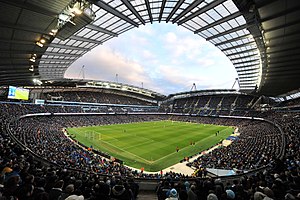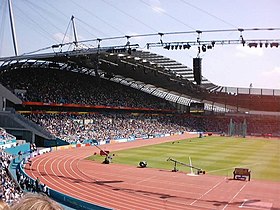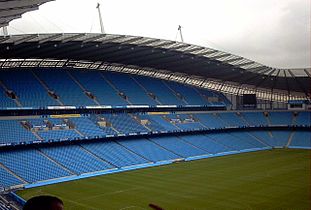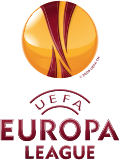Etihad Stadium (Manchester)
| City of Manchester Stadium Etihad Stadium |
|
|---|---|
| COMS Eastlands The Blue Camp Sportcity The Etihad |
|
|
|
|

|
|
| The Etihad Stadium in Manchester (2016) | |
| Sponsor name (s) | |
|
|
| Data | |
| place | Ashton New Road Manchester M11 3FF, United Kingdom |
| Coordinates | 53 ° 28 '59 " N , 2 ° 12' 2" W |
| classification | 4th |
| owner | Manchester City Council |
| operator | Manchester City |
| start of building | January 2000 |
| opening | July 25, 2002 (athletics) |
| First game | 10 August 2003 Manchester City - FC Barcelona |
| Extensions | 2014–2015 (South Stand) |
| surface |
Hybrid lawn (Desso GrassMaster) |
| costs | £ 110 million |
| architect | Arup Associates |
| capacity | 55,097 seats |
| playing area | 105 × 68 m |
| Societies) | |
| Events | |
|
|
The Etihad Stadium , originally and in UEFA competitions City of Manchester Stadium is a football stadium in the English city of Manchester , United Kingdom . It is the home ground of Manchester City football club . Colloquially the stadium is also called COMS , Eastlands , The Blue Camp , Sportcity or The Etihad .
The stadium was originally built for the Commonwealth Games in 2002 , but then converted into a pure football stadium. The stadium currently has a capacity of 55,097 spectators and is currently treated by the Old Trafford is the second largest stadium in Greater Manchester and after the Tottenham Hotspur stadium , the Emirates Stadium and the Olympic Stadium in London, the fifth largest football stadium in the Premier League . On July 8, 2011, Manchester City announced that they had signed a ten-year sponsorship deal with Etihad Airways for the stadium name. The stadium has been called the Etihad Stadium ever since.
history
In 1993 the city of Manchester competed for the 2000 Olympic Games and made plans for a new stadium in the east (Eastlands district) of the city with a capacity of 80,000 spectators. After the bid went to Sydney , Australia , a successful bid was made to host the 2002 Commonwealth Games . The construction plans were initially adhered to, but after the English Football Association (FA) decided to build the new Wembley Stadium in London as England's national stadium , the plans were revised and the capacity was set at 38,000 spectators. At the same time, an agreement was signed with the Manchester City club in which the conversion of the stadium after the games into a pure football arena with 48,000 spectators and the use of the stadium by the club for the next 250 years were stipulated.
Prime Minister Tony Blair laid the foundation stone for the stadium on December 17, 1999 ; work began a month later. The stadium was designed by the London architects Arup with continuous and slightly curved grandstands. On July 25, 2002, Queen Elizabeth II opened the stadium under the name City of Manchester Stadium and the Commonwealth Games . All athletics and rugby games were held here.
After the Commonwealth Games, the conversion into a pure football stadium began. The running track and all other athletics sites have been removed. The first tier was lowered and a temporary grandstand was replaced by a new permanent grandstand. A total of 10,000 new places could be won. The entire renovation costs were borne by the Manchester City club, which left its old home stadium, Maine Road , after the 2002/03 season and moved into the new stadium. On June 1, 2004, the stadium became the 50th stadium in which the English national football team played a home game.
The stadium is part of the Sportcity sports complex . Next to the football stadium there is also a regional athletics arena , which has a capacity of 6,000 and is used for athletics elimination competitions and Manchester City's second team play their home games. Next to it are the cycling hall ( Manchester Velodrome ) and the National Squash Center .
The stadium is designated as a four-star stadium by UEFA . It was chosen as the venue for the 2007/08 UEFA Cup final .
In addition to its main function today as a football stadium, it serves as a venue for other major sporting events, such as B. Rugby Football League games and concerts.
useful information
The stadium has the largest football pitch in the UK due to its past as an athletics arena. Around 20 million artificial turf fibers were inserted 20 cm deep into the natural turf of the playing field . Over time, the natural turf grows together with the artificial fibers and becomes very resistant. In 2003 the stadium won the Structural Special Award from the Institution of Structural Engineers and in 2004 the RIBA Inclusive Design Award. The east stand is named after former Manchester City player Colin Bell . The record attendance was 54,502 in the Premier League game against AFC Bournemouth (5-1) on October 17, 2015.
expansion
In mid-May 2013 the plans matured to expand the Citizens' venue . At the end of 2013, Manchester City submitted the building application to expand the stadium. The capacity of approx. 48,000 visitors is to increase to 62,170. This is mainly to be achieved by adding a third tier to the back-gate stands. The cost of the construction work according to the architecture firm Populous should amount to 60 million euros. Work began in spring 2014. In February 2014, the City of Manchester approved plans for the expansion. The first two expansion stages were completed at the start of the 2015/16 season . For this, Manchester City asked the Premier League for an away game on the first matchday to do final work on the stadium. This request was granted, so that the Citizens' first home league game took place in the enlarged stadium on August 16, 2015 against Chelsea.
The expansion of the North Stand is currently pending (as of October 2019).
gallery
The stadium during the 2002 Commonwealth Games
Scene from the UEFA Champions League match against Bayern Munich on December 7, 2011
Panorama picture
Web links
- Stadium website
- Stadium description Football Ground guide (English)
- Picture gallery on Stadionwelt.de
- Visitor report from 2003
Individual evidence
- ↑ premierleague.com: Premier League Handbook Season 2015/16 - page 19 ( PDF , English)
- ↑ Million deal: ManCity renames its stadium , article from July 8, 2011.
- ↑ bbc.com: Magic Weekend: Etihad Stadium to host event until 2014 Article from 2012 (English)
- ^ Concerts and Events at the Etihad Stadium ( Memento from March 15, 2014 in the Internet Archive )
- ↑ Desso GrassMaster at Etihad Stadium
- ↑ weltfussball.de: Record attendance (English)
- ↑ Manchester City expands stadium capacity , stadionwelt.de, article from October 17, 2013.
- ↑ Building application submitted for the expansion of the Etihad Stadium , stadionwelt.de, article from December 3, 2013.
- ↑ Etihad Stadium is being expanded , stadionwelt.de, article from February 13, 2014.
- ↑ stadiumdb.com: Expansion of the Etihad Stadium (English)
- ↑ Manchester City wants to start away from home , stadionwelt.de, article from June 14, 2015.






